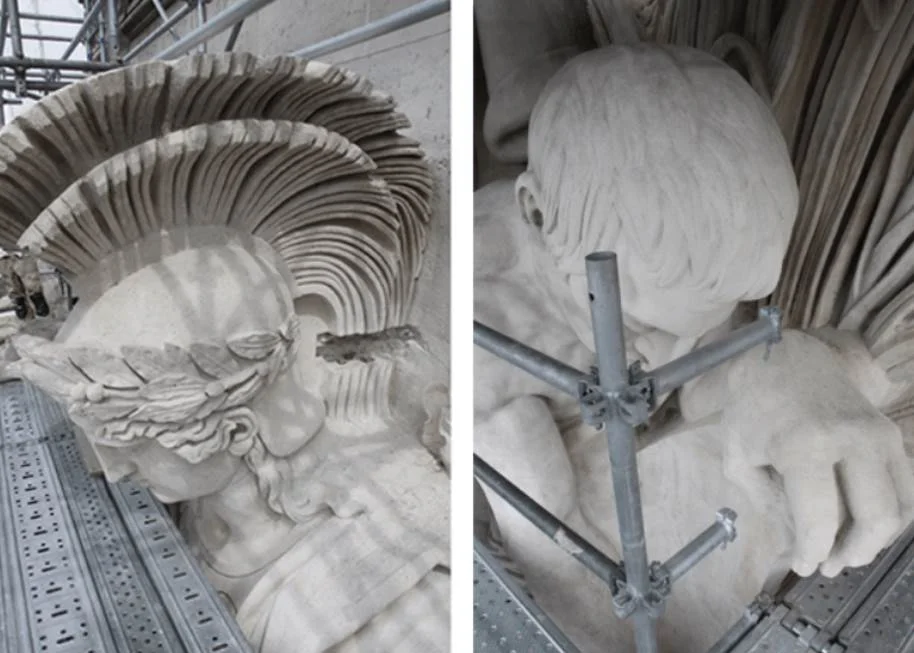In this list with facts about the Arc de Triomphe in Paris, You’ll learn everything you need to know about this historic landmark in the capital of France.
The city of Paris also referred to as “La Ville Lumière,” is arguably one of the most beautiful cities in the world.
The number of historical buildings with intriguing stories in Paris is immense. One of those buildings, a triumphal arch that is located in the center of Paris, is the Arc de Triomphe.
Let’s take a closer look at the most interesting facts about the Arc de Triomphe and why it’s considered one of the most famous arches in France and one of the most noteworthy monuments in the city of Paris.
1. What is the Arc de Triomphe’s full name?
The full name of the Arc de Triomphe is “The Arc de Triomphe de l’Étoile.” This translates into the “Triumphal Arch of the Star.”
The reason for this is that it was formerly named after its location on the “Place de L’étoile,” which has been renamed “Place Charles de Gaulle” after the death of the former president in 1970.

2. Where is the Arc de Triomphe located in Paris?
It’s located on the west side of the most famous avenue in Paris, the Champs-Elysees and right at the center of the “Place Charles de Gaulle.” It’s also located on the right bank of the river Seine.
An interesting fact about the Arc de Triomphe regarding its location is that it’s located in 3 different neighborhoods of Paris (called “Arrondissements”). It shares the location with the 8th, 16th, and 17th arrondissements.
12 avenues come together where the Arc de Triomphe is located.
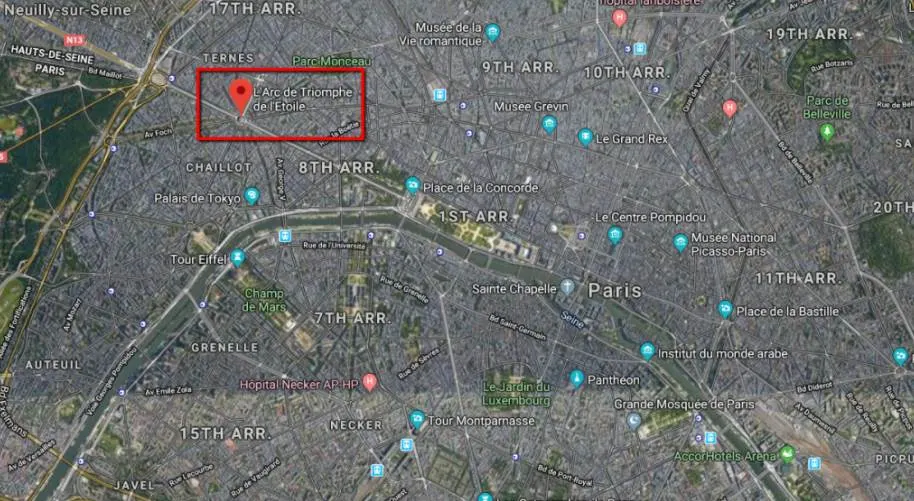
3. When and Why was the Arc de Triomphe built?

The construction of the Arc de Triomphe started in 1806 and the monument was completed in 1836 and officially inaugurated on July 29 of that year.
It was started by Emporer Napoleon after the famous victory of Austerlitz.
The Arc de Triomphe is a remembrance of the French soldiers who died during the French Revolution and the Napoleonic wars.
It’s a patriotic monument that was inspired by the Arch of Titus in Rome and has the names of all French victories and generals engraved into it on both the inside and the outside.
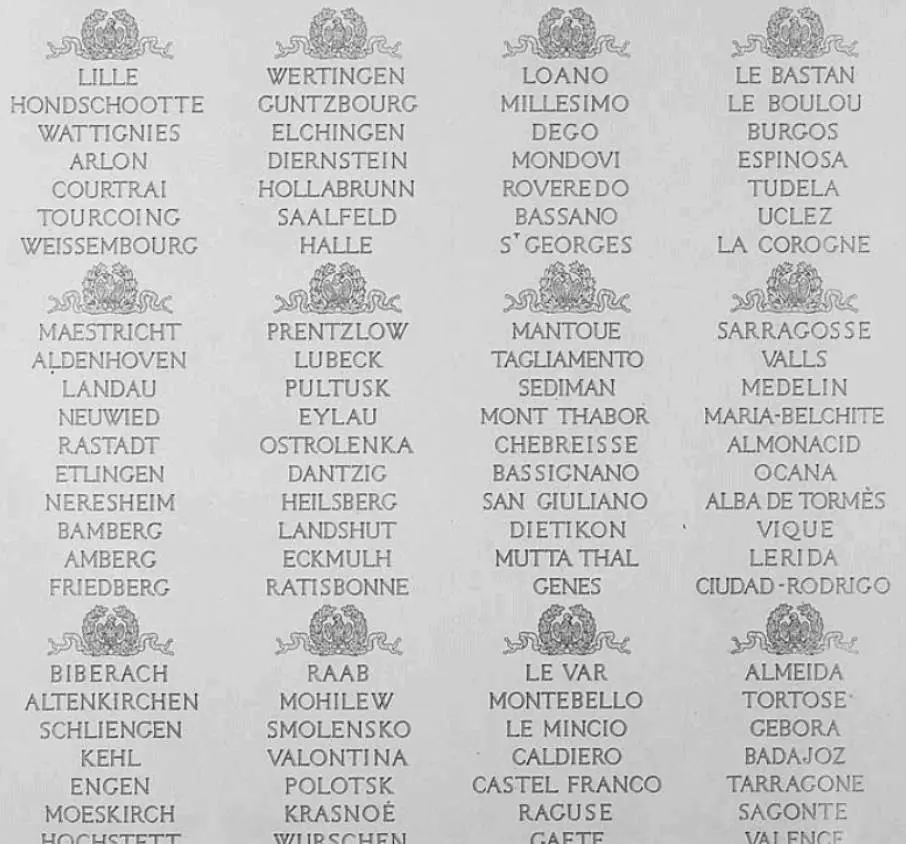
4. Napoleon never saw the completed Arc
Because of the enormity of the structure, it took 30 years to complete the Arc de Triomphe.
Because it took such a long time, Emperor Napoléon Bonaparte who died in 1821, never got to see the final version of the Arc.
In 1810 however, he and his wife Marie-Louise entered Paris underneath a wooden arc which was used as a model for the future Arc de Triomphe.
5. How big is the Arc de Triomphe?
The Arc de Triomphe is an enormous structure and was for a very long period the largest triumphal arc in the world.
Right now it’s third after:
- The 1938 Monumento a la Revolución in Mexico City, Mexico.
- The 1982 Arch Of Triumph in Pyongyang, North Korea.
Its measurements are:
- Height of 50 meters (164 ft).
- Width of 45 meters (148 ft).
- Depth of 22 meters (72 ft)
Surprisingly enough, the world’s tallest arc is also located in Paris and is called “La Grande Arche.” This arc is located in the business district of Paris “La Defence.”
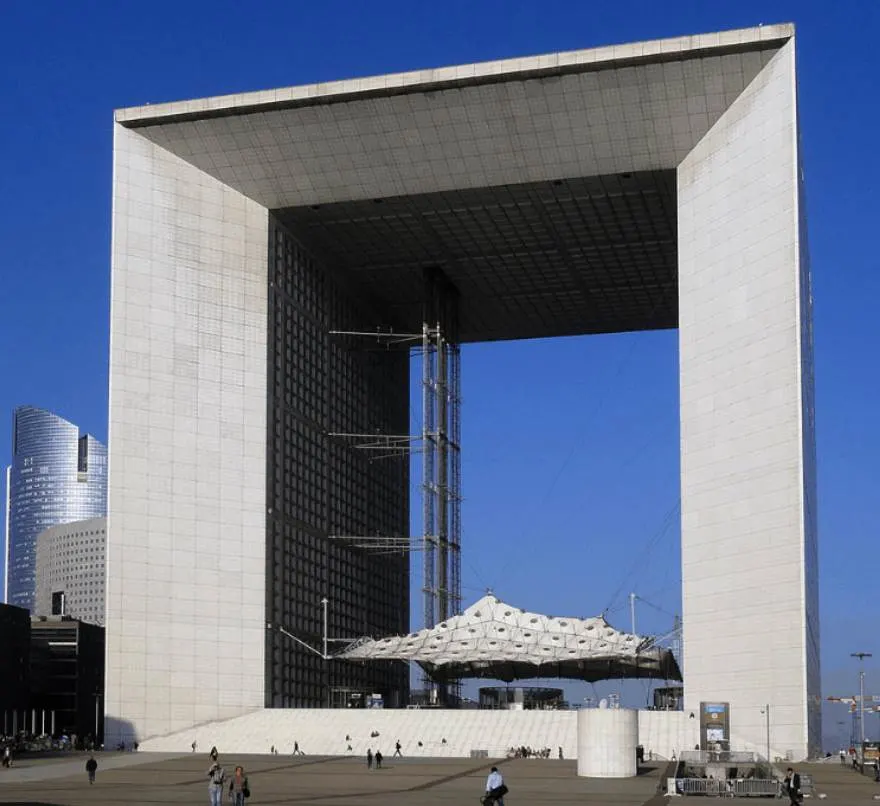
6. Arc de Triomphe or giant elephant?
After the demolishing of the Bastille, a prison which was disliked by most Parisians, the question arose about what would replace it.
Long before the decision needed to be made, an architect named Charles Ribart already proposed to create a monument reflecting a giant elephant in 1758.
His proposal was rejected.
Napoleon had a similar idea and wanted the elephant to be made out of bronze melted down from canons he captured during his victories.
The bronze never arrived and that’s how the Arc de Triomphe became the main choice for the glorious replacement of the bastille.
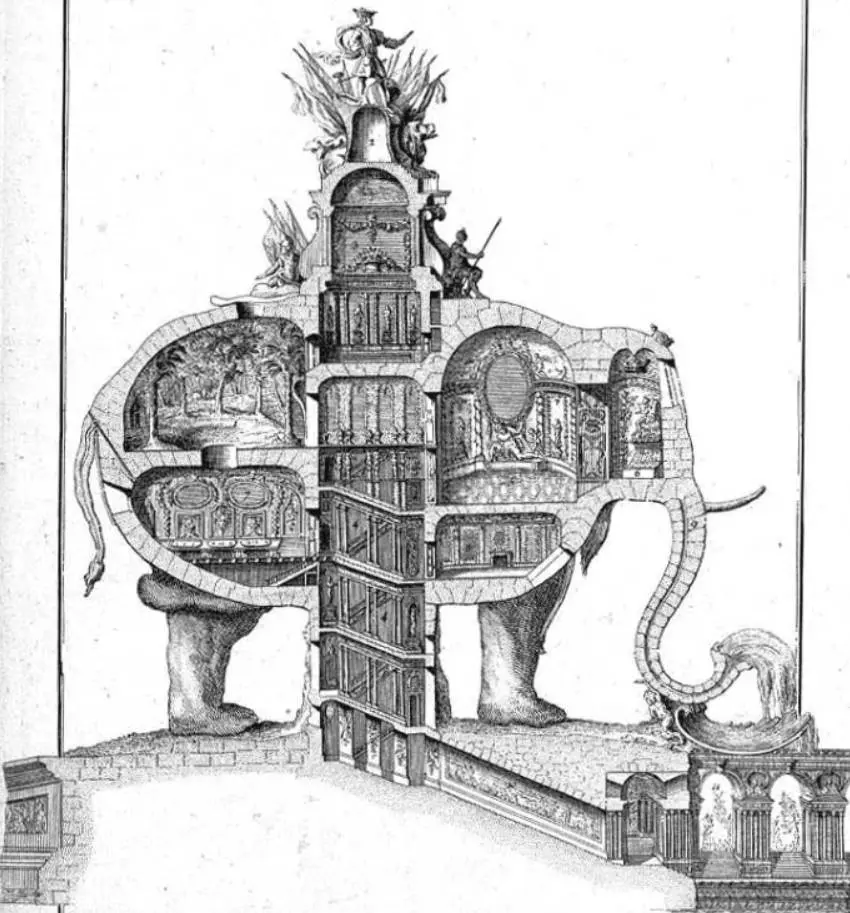
7. Construction of the Arc de Triomphe was halted for 15 years
Ever wonder why it took just over 30 years to complete the construction of the Arc de Triomphe?
It’s a very delicate monument with numerous sculptures and details that add years to the finishing. The main reason though is that the construction was halted during the Bourbon Restoration, a period following the fall of Napoleon in 1815 that lasted until 1830.
During the reign of King Louis-Philippe, in between 1833 and 1836) the Arc de Triomphe was finally completed.
8. Return of Napoleon
After being permanently exiled to the island of Saint-Helena, Napoleon Bonaparte died in 1821.
This means that he never came to see his finished product, the Arc de Triomphe he started building to commemorate the French people that fought during the French revolution and Napoleonic wars.
When his body was brought back to Paris, it was walked under the Arc de Triumph (just like he did when entering Paris with his wife) before being put to its final resting place at “Les Invalides” in 1840.
9. A Little Accident happened in 1916
One of the sculptures on the Arc de Triomphe depicts the start of the French Revolution, and is referred to as “Le Départ” or “La Marseillaise.”
On the day that the Germans collided with the French in WWI in the Battle of Verdun, the sword of this sculpture miraculously broke off.
The proper authorities quickly covered up the sculpture with large sheets so the public wouldn’t be able to see it.
Unfortunately for the French, a lot of lives were lost in the longest battle of WWI, and had the news about the accident spread earlier, it would have been considered an omen for what was to follow.

10. Grave of the unknown soldier
Beneath the Arc de Triomphe, a tomb is found with a grave of an unknown soldier from World War I, remembering all the unidentified people that lost their lives during both the first and second World Wars.
The unknown casualties of the war are remembered in a ceremony once a year on November 11, the exact day that the first World War was finally over.
An eternal flame has been lit on 11th November 1923 by Andre Maginot to not just remember the people that lost their lives on that particular day, but every single moment until eternity.

11. Eternal flame for JFK
John F. Kennedy, the American president at that time, visited the Arc de Triomphe and the tomb of the unknown soldier in Paris in 1961 with his wife Jackie Kennedy.
After the assassination of JFK, Jackie had remembered the eternal flame next to the tomb of the unknown soldier in the Arc de Triomphe and requested the same to be placed next to the grave of her late husband at Arlington National Cemetery in Virginia.
Jackie lit the candle which is still burning today.
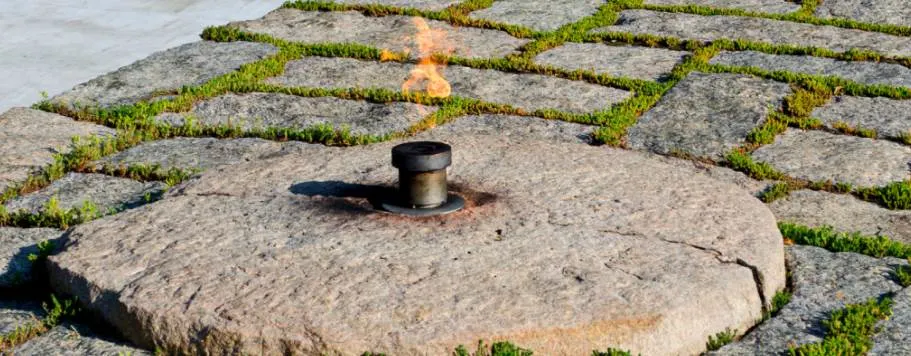
12. 2 Assassination attempts
Near the Arc de Triomphe, there have been two assassination attempts.
- One of the 30 assassination attempts on Charles de Gaulle, the French president for 10 years from 1959 until 1969, happened right next to the Arc de Triomphe.
- In 2002, Jacques Chirac narrowly escaped an assassination attempt as he was addressing troops from an open jeep.
Since these were assassination attempts, neither of the perpetrators was successful.
13. The Arc de Triomphe contains multiple sculptures and reliefs
Most of the sculptures and reliefs on the Arc de Triomphe represent an event during the French Revolution or the Napoleonic Wars.
It’s the epitome of triumphant monuments containing patriotic messages and inspired numerous other monuments around the world to be built with the same idea.
4 Main sculptures on the Arc’s pillars
Le Départ de 1792 – Also referred to as “La Marseillaise” by François Rude
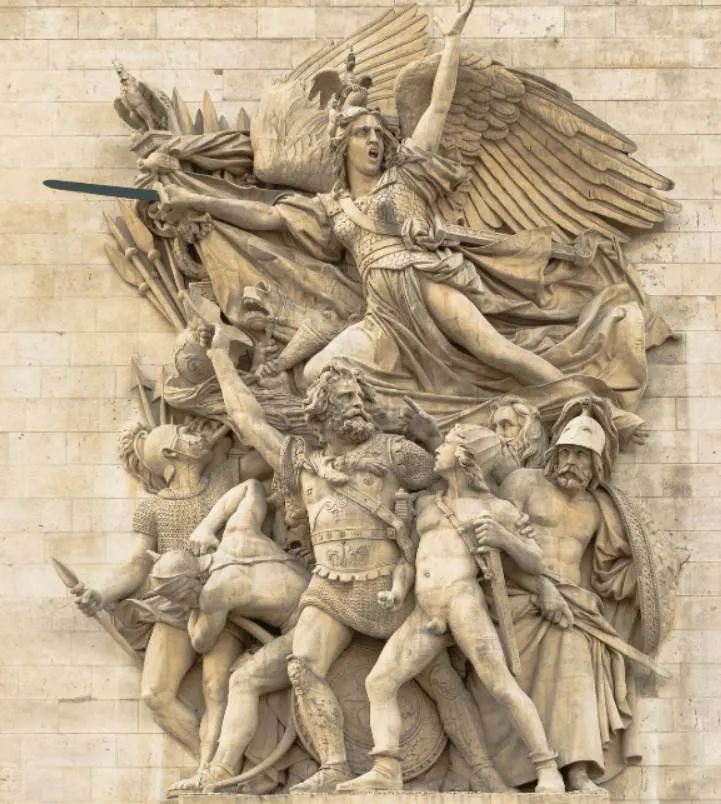
Le Triomphe de 1810 by Jean-Pierre Cortot
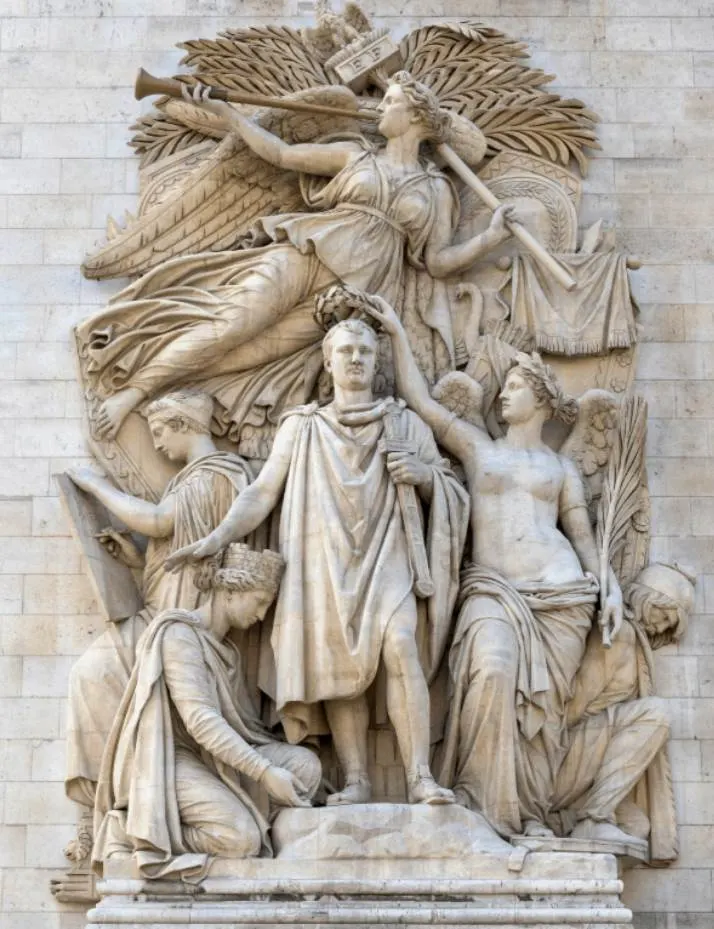
La Résistance de 1814, by Antoine Étex
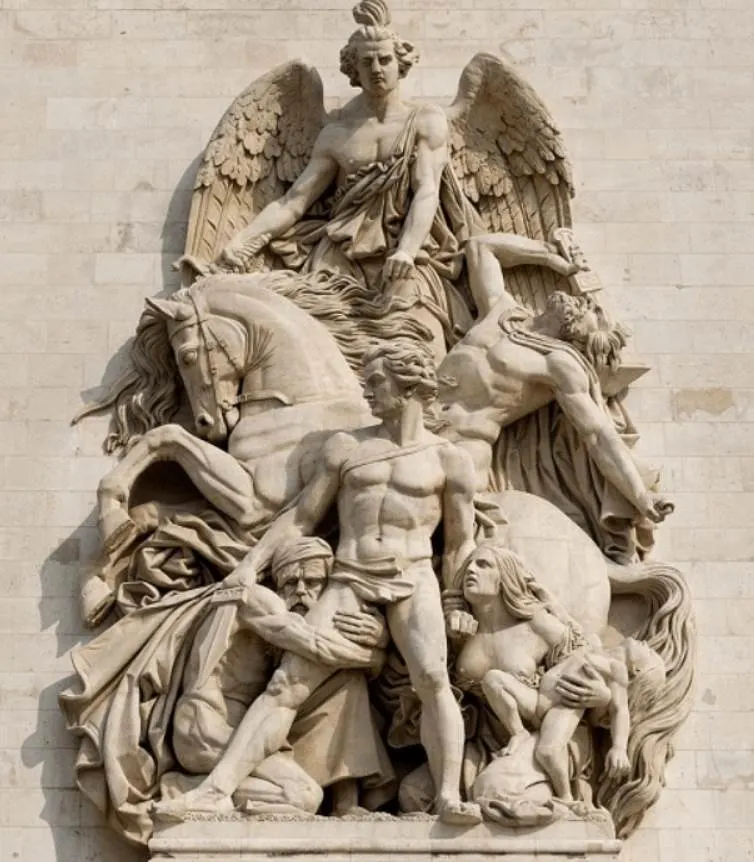
La Paix de 1815, by Antoine Étex
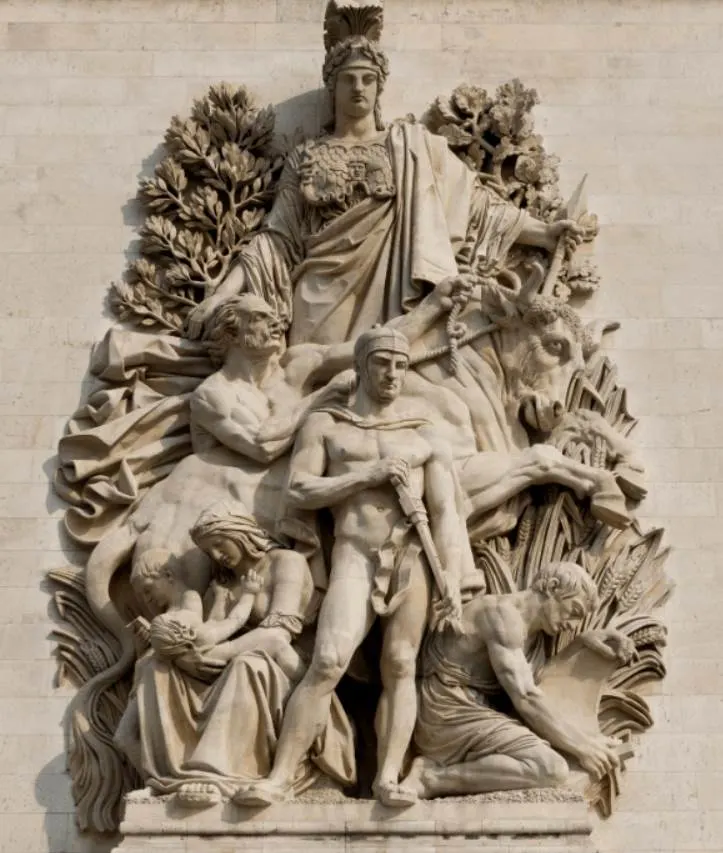
The 6 main reliefs
- Les funérailles du général Marceau by P. H. Lamaire (SOUTH façade, right),
- La bataille d’Aboukir by Bernard Seurre (SOUTH façade, left),
- La bataille de Jemappes by Carlo Marochetti (EAST façade),
- Le passage du pont d’Arcole by J. J. Feuchère (NORTH façade, right),
- La prise d’Alexandrie by J. E. Chaponnière (NORTH façade, left),
- La bataille d’Austerlitz by J. F. T. Gechter (WEST façade),

14. Charles Godefroy and his remarkable exploit
Celebrating the end of World War I and saluting all the soldiers that lost their lives needs to be done spectacularly.
What better way than to fly your Nieuport fighter plane through the Arc de Triomphe that commemorates equally important battles and its soldiers?
That’s exactly what Charles Godefroy did, see the footage of that day in 1919 below:
Godefroy wasn’t the actual pilot that was supposed to do the job. That role was reserved for Jean Navarre.
Unfortunately Jean lost his life just a couple of weeks before in a crash, while he was training for this event.
15. Saddest moment in Arc de Triomphe’s history
As you can see from this list of facts about the Arc de Triomphe in Paris, it has been through a lot.
One of its most memorable, and at the same time saddest moments in its 200+ year history, happened on June 14, 1940.
It had been more than 70 years that the Arc had seen German troops, yet they were back again. This time with tanks, rolling into the streets of Paris.
Luckily, the “triumph des Willens” proved to be no match for the mighty Arc de Triomphe.
After World War II, the forefathers and heroes of the French republic could be commemorated yet again after this dark moment in human history.

16. Let’s keep the Arc the Triomphe clean
The Arc de Triomphe hadn’t been cleaned for nearly 20 years when it came to light that the state of the monument had been deteriorating.
The Chief Architect of Historical was assigned to hire several contractors to remove the built-up dirt, mostly caused by pollution (yes Paris is a heavily polluted city due to the immense traffic).
After a huge endeavor, the work was finished, a damp-proofing to protect the external surface has been applied and we can wait another 20 years to make one of Paris’ most famous landmarks look pretty again.
